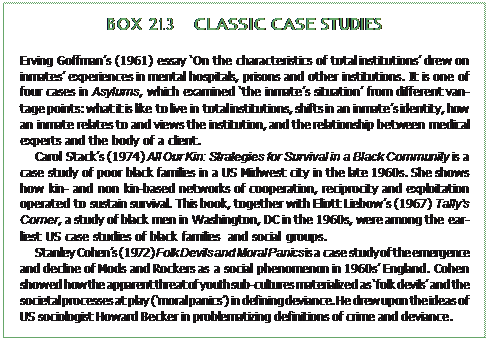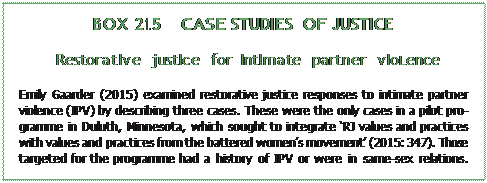 |
Case studies in action:some classics
|
|
|
|
CASE STUDIES IN ACTION: SOME CLASSICS
Let us see case studies in action, first with reference to some classic case studies (Box 21. 3). What each of these is ‘a case of ’ is, respectively, total institutions, black families and social groups, and social reaction to youth sub-cultures. All the cases are descriptive and syn- chronic, but they generated new ways of understanding self and identity, kin and friendship networks, and social responses to deviance.
 |
CASE STUDIES IN ACTION: CONTEMPORARY CRIMINOLOGY
For contemporary examples, I consider case studies of crime and disorder, justice and comparative criminology.
Crime and disorder
Box 21. 4 has two case studies. The first describes five sub-types of homicide that target anti-lesbian, gay, bisexual and transgender (LGBT) individuals. Kelley and Gruenewald (2015) theorize homicide as a situated transaction and use the construct of ‘doing masculinity’ to analyse offenders’ motives for targeting a perceived LGBT person. Homicide and other violent offences such as robbery and sexual violence are frequent subjects of case study analysis. Researchers examine the sequence of moves and counter-moves in violent episodes, and they attempt to reach into the subjec- tivities of offenders and victims, as the violence unfolds.
The second is a case study of a significant political and social event – the riots in England in August 2011 – to determine what groups were involved, why they looted and what legal authorities did during and after the riots. It shows how an event such as social disorder can be studied, using varied evidence sources (interviews, arrests, court prosecutions, social media). It also shows the value of examining what happens after an event, and, in this case, police and court responses to alleged and convicted offenders. Newburn (2015) compared what occurred in 2011 with other urban dis- orders in post-war England and Wales, and from this he identified a model for carrying out comparative analyses of riots.
 |

Justice
Justice processes and outcomes lend themselves to case study analysis: legal research is case-based (although it may or may not use social science methods), and criminological research has long focused on police and court responses to crime and victimization. We need to be especially attentive to the question, ‘what is this a case of ? ’, when designing research on justice. One legal case can be sufficiently significant to be one case study (for example, see Gies, 2017). However, other legal cases such as sentencing decisions may need to be aggregated to form a substantive case for case study. Three examples are given in Box 21. 5, one of which draws from my research.
The first examines the dynamics of restorative justice (RJ) practices for inti- mate partner violence (IPV) cases. Like decisions in youth courts and some specialist courts, restorative justice practices are not open to the public and can be observed only if you have permission. Thus, we require research on what is occurring. For each case, Gaarder (2015) analysed the perspectives of an admit- ted offender and victim before, during and after the circles; change or relapse in
|
|
|
an offender’s behaviour; and the impact on a victim. The depth of detail about each person’s concerns and circumstances – of drug abuse, unemployment, cus- tody of a child – brought forward the complexities of addressing IPV in a justice process.
The second, of two mothers’ experiences supporting their sons in youth court, shows how and why they become increasingly disengaged with court processes. We might have expected that the mothers’ differing racial and socio-economic circum- stances would have shaped their orientations to the court process. However, the courts’ organizational logic, and the roles and responsibilities of court actors, were more determining. Pennington (2015) calls for procedural justice researchers to pay closer attention to context and consider the many points of interaction (not just one) between legal authorities and citizens.
My research (Daly, 2014) examined the ways in which institutions, states and provinces, and two countries (Australia and Canada) responded to the historical institutional abuse of children. It sought to historicize the emergence of institutional abuse as a social problem, compare responses by authorities and determine whether there was an optimal redress response from victim-survivors’ perspectives. When carrying out the research, I worked iteratively between two levels of analysis: an in- depth case study of each of the 19 cases and a cross-case analysis of many relevant variables. My design combined case study and cross-case research. Previous research by others had analysed cases in one jurisdiction or one redress mechanism (for exam- ple, public inquiries) across cases. I drew inspiration from research on transitional justice, in which authors have compared one or more justice mechanisms (truth com- mission, criminal prosecution, lustration or purges) for countries in transition (Backer, 2009; Hayner, 2011). Australia and Canada are often considered to be similar in comparative case study research, and I compared the two for some out- comes (thus, a most similar design). However, my primary aim was to describe and understand the diversity of redress in the two countries rather than to compare each country.
 |

The RJ protocol had separate circles for the victim (the support circle) and the admit- ted offender (the sentencing circle). With other colleagues, Gaarder spent about 200 hours in participant-observation and carried out interviews with 29 people (victims, offenders, support people, victim advocates, among others). The research focused on what happened during the circles (which often met many times) and afterwards, with follow-up data on re-offending for five years after each offender’s last circle. The design was a single case study (with three legal cases) and synchronic, although the cases were followed over time. It was descriptive, and there was no selection from a larger pool of cases.
Parental perceptIons of procedural justIce In youth court
|
|
|
Liana Pennington (2015) described the experiences of two mothers, Kit and Judy, whose sons were before youth courts in the US north-east. The two were selected from 30 families who had youth in court, of which a high share (24) reported ‘dissatis- faction and disengagement in the court process’ (2015: 905). Kit and Judy were selected as typical cases of parental disengagement. Kit was African-American, unemployed and lived in an economically disadvantaged part of the city served by Court 1; Judy was white, employed and lived in a more suburban setting served by Court 2. Drawing from the literature on procedural justice and legal consciousness, Pennington explored Kit’s and Judy’s experiences as parents at three points: before going to court, during the mid-court stages and at the final stages. Her many observa- tions in court and interviews over a 10-month period revealed that Kit’s and Judy’s initial enthusiasm to participate in a legal process was undermined by the court staff and the court’s routines. Despite racial and socio-economic differences, both mothers became more passive and no longer interested in participating in the court activity. The case study used a most-different design, in which the mothers’ backgrounds and the areas served by the courts differed, but the women experienced the same outcome. It was causal (exploratory) in showing the mechanisms that led to their disengagement.
Redress for hIstorIcal InstItutIonal aBuse
My research on historical institutional abuse (Daly, 2014) examined 19 cases of redress activity in Canada and Australia. Some cases were of one organization, and others were large, including redress by a state or country. I sought to explain why institutional abuse emerged as a social problem in the 1980s and to map authorities’ responses (criminal prosecution, public inquiries, civil litigation and redress schemes). I created variables to compare who and what were the subjects of redress; how long it took authorities to respond; the structure of
(Continued)

|
|
|


